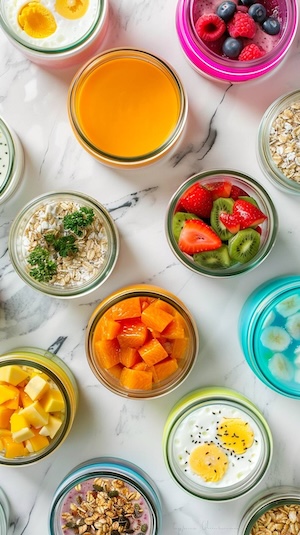PCOS for Picky Eaters: 30 Simple Meal Ideas
Discover 30 simple pcos meals for picky eaters that help manage symptoms. Easy pcos meals picky eaters will love, with practical tips and hormone-balancing ingredients.
This recipe includes superfoods such as:
Transform your health with tailored 7-day meal plans designed specifically for PCOS management. Just $7/month or $59/year.
Get it now →1/2 cup sugar
1 cup raw peanuts
Coarse sea salt
For the peanuts: In a skillet set over medium heat, add the sugar and 2 tablespoons water. Cook, stirring occasionally, until the sugar is grainy, about 15 minutes. Add the peanuts and stir to coat. Increase the heat and cook until the sugar just starts to melt. Sprinkle in some salt and stir to make sure all peanuts are coated in the sugar syrup. Transfer to a baking sheet and place on a cooling rack to cool until hard, 25 to 30 minutes. Transfer the peanut mixture to the bowl of a food processor, and pulse until coarsely ground. For the rice: Place the rice in a mixing bowl and cover with cool water. Swirl the rice, then pour off the water and repeat until the water runs clear, 2 to 3 more times. Bring 1 1/2 cups water to a boil. Add the rice, reduce the heat to a simmer and cover the pot; cook for 30 minutes. Turn off the heat and rest the rice for 10 minutes. Transfer the rice to a large glass or wooden mixing bowl, then add the mirin and rice vinegar. Fold to combine and coat the rice, then cool to room temperature. For the teriyaki: In a mixing bowl add the tamari, 2 tablespoons water, the vinegar, agave, garlic and ginger. Pour half of the teriyaki sauce in a small pot set over low heat and cook until the liquid reduces by half. Add the sesame oil to the other half of the teriyaki sauce and reserve for a later use. For the aioli: In the pitcher of a blender, add the Sriracha, pepper, salt, garlic, egg yolk and lime juice. With the blender running on medium speed, slowly drizzle in the olive oil and vegetable oil. For the musubi: In a mixing bowl, toss the crushed peanuts, black sesame seeds, white sesame seeds and red pepper flakes. Place the Spam slices in the reserved teriyaki sauce and soak for 5 minutes. Remove the Spam with a slotted spoon and discard the teriyaki. Heat a saute pan set over medium heat, and cook the Spam until a crust forms on the outside edge and the slices are heated through, 2 to 4 minutes. Place about 1/4 cup of the rice in the center of a piece of nori and shape into a rectangle. Layer 4 to 6 pieces of the carrots and 4 to 6 pieces of the cucumber on top of the rice. Place a piece of Spam on top of the veggies and roll the nori around the filling. Brush the edges of the nori with the reduced teriyaki sauce to seal the edges. Repeat for the remaining nori, rice, veggies and Spam. Brush each roll all over with the reduced teriyaki sauce, and then either sprinkle or roll the musubis in the peanut mixture, about 2 tablespoons per roll. Sprinkle each roll with 1 teaspoon green onions, then drizzle with 1 teaspoon of the reduced teriyaki sauce and 1 tablespoon of the spicy aioli to serve. Cook's Note: Reserve any leftover rice for another use. Brown rice is a whole-grain alternative to white rice. Unlike white rice, which is highly processed, brown rice contains the bran and germ of the rice grain and therefore contains more dietary fiber, vitamins, and minerals. Brown rice also contains iron, zinc, thiamin, niacin, vitamin B6 and magnesium. Instead of frying, we use peanuts and sesame seeds for crunch. Peanuts not only add flavor, but also protein, fiber and healthy fats. Food Network Kitchens suggest caution in consuming raw and lightly cooked eggs due to the risk of Salmonella or other food-borne illness. To reduce this risk, we recommend you use only fresh, properly refrigerated, clean, grade A or AA eggs with intact shells and avoid contact between the yolks or whites and the shell. For recipes that call for eggs that are raw or undercooked when the dish is served, use shell eggs that have been treated to destroy Salmonella, by pasteurization or another approved method.

You know the drill: Alarm goes off. You hit snooze. Rush around frantically. Skip breakfast AGAIN because there's no time. By 10am, you're hangry, your blood sugar is all over the place, and your PCOS symptoms are already acting up.
Sound familiar?
Finally – a meal prep system designed specifically for women with PCOS who refuse to let chaotic mornings derail their health goals.
In just ONE hour on Sunday, you can transform your entire week:
"I went from skipping breakfast 4 days a week to having delicious, hormone-supporting meals ready every morning. My energy is more stable and my cravings have disappeared!"
– Sarah M.
Stop letting chaotic mornings control your health.
Get your hormone-happy mornings starting this Sunday.
→ Get Your 60-Minute Solution Now
Transform your health with tailored 7-day meal plans designed specifically for PCOS management. Just $7/month or $59/year.
Get it now →Serving Size: 6
| Amount Per ONE Serving | ||
|---|---|---|
| Calories 0 kcal | ||
| Fat 0 g | ||
| Carbohydrate 0 g | ||
| Protein 0 g | ||
💡 Introducing the 10/10 PCOS Solution:
Ten Delicious Crockpot Recipes that take just 10 minutes to prep!
Say goodbye to hours in the kitchen and hello to clean, PCOS-friendly meals made effortlessly.
👉 Click here to grab your 10/10 PCOS Solution today! Try The 10/10 PCOS Solution: Ten Crockpot Recipes That Take Just Ten Minutes to Prep
Managing PCOS can be challenging, but you don't have to do it alone. Join our supportive community to connect with others who understand what you're going through, share tips, and get encouragement. Here's how you can get involved:
Subscribe to our Newsletter: Receive PCOS-friendly recipes, tips, research updates, and more delivered straight to your inbox. Stay informed and empowered with the latest information and support.
Join our Telegram Channel: Stay updated with the latest tips and advice on managing PCOS.
Follow PCOS Meal Planner on Facebook: Engage with our community, participate in discussions, and get support from others.
Break the cycle with the PCOS Meal Planner - your personalized guide to eating better, feeling better, and managing PCOS symptoms. Take control today!

Forget the frustrating cycle of weight loss attempts, endless medications, and living in discomfort. Introducing the PCOS Meal Planner. A meal planning guide that goes beyond temporary fixes to offer a comprehensive strategy, empowering you to ignite a transformation towards lasting health and happiness. Step into a world where you control your PCOS, not the other way around.
Unlock Your PCOS Freedom Now.
Discover 30 simple pcos meals for picky eaters that help manage symptoms. Easy pcos meals picky eaters will love, with practical tips and hormone-balancing ingredients.
Discover 15 delicious overnight oats for PCOS recipes that help balance hormones and manage symptoms. Easy, nutritious breakfast ideas perfect for women with PCOS.
Discover the best cereal for PCOS with our expert rankings. Compare brands, check ingredients, and find PCOS friendly cereal that supports hormonal balance.
Learn how to transition away from fruit when starting a ketogenic diet for PCOS. Discover gradual strategies, fruit alternatives, and practical tips for success.
Discover 5 delicious PCOS banana bread recipes with low-glycemic ingredients. Learn how to make hormone-friendly banana bread that supports blood sugar balance.
Creatine for women with PCOS explained simply. Learn safety, benefits, hormone effects, tips, and how creatine may support PCOS symptoms naturally.
Complete PCOS diet plan with foods to eat, foods to avoid, meal timing, and real results. Learn the science-backed approach to managing PCOS through diet, with 7-day meal plan, grocery list, and step-by-step implementation guide. Based on clinical research and real patient outcomes.
Complete guide to ordering at Wendy's with PCOS. Discover the best protein-focused meals, what to skip, and how to customize orders to keep blood sugar stable. Learn which burgers, salads, and sides work for PCOS, plus complete macros for every menu item and smart swaps to avoid insulin spikes.
Complete guide to ordering at Burger King with PCOS. Discover the best protein-focused meals, what to skip, and how to customize orders to keep blood sugar stable. Learn which burgers, salads, and sides work for PCOS, plus complete macros for every menu item and smart swaps to avoid insulin spikes.